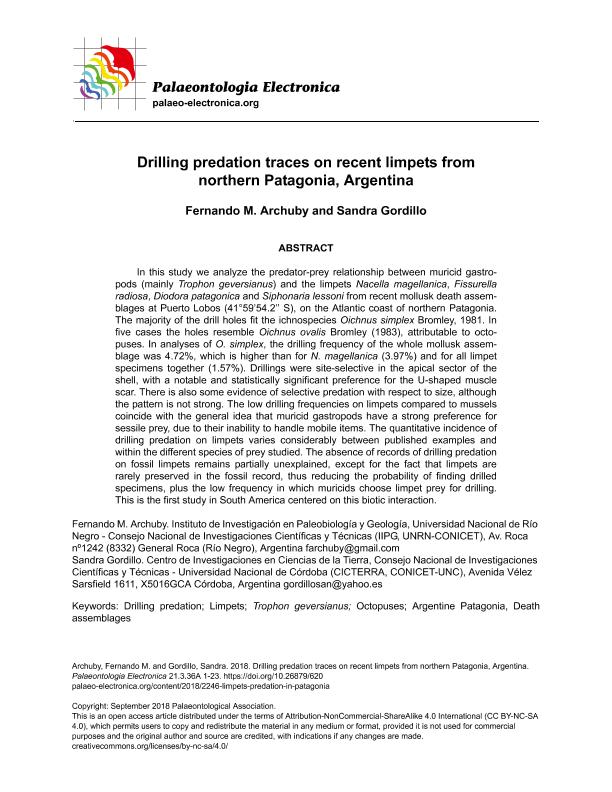Mostrar el registro sencillo del ítem
dc.contributor.author
Archuby, Fernando

dc.contributor.author
Gordillo, Sandra

dc.date.available
2019-11-08T23:50:40Z
dc.date.issued
2018-09
dc.identifier.citation
Archuby, Fernando; Gordillo, Sandra; Drilling predation traces on recent limpets from northern Patagonia, Argentina; Coquina Press; Palaeontologia Electronica; 21; 3; 9-2018; 1-23
dc.identifier.issn
1094-8074
dc.identifier.uri
http://hdl.handle.net/11336/88400
dc.description.abstract
In this study we analyze the predator-prey relationship between muricid gastropods (mainly Trophon geversianus) and the limpets Nacella magellanica, Fissurella radiosa, Diodora patagonica and Siphonaria lessoni from recent mollusk death assemblages at Puerto Lobos (41°59’54.2’’ S), on the Atlantic coast of northern Patagonia. The majority of the drill holes fit the ichnospecies Oichnus simplex Bromley, 1981. In five cases the holes resemble Oichnus ovalis Bromley (1983), attributable to octopuses. In analyses of O. simplex, the drilling frequency of the whole mollusk assemblage was 4.72%, which is higher than for N. magellanica (3.97%) and for all limpet specimens together (1.57%). Drillings were site-selective in the apical sector of the shell, with a notable and statistically significant preference for the U-shaped muscle scar. There is also some evidence of selective predation with respect to size, although the pattern is not strong. The low drilling frequencies on limpets compared to mussels coincide with the general idea that muricid gastropods have a strong preference for sessile prey, due to their inability to handle mobile items. The quantitative incidence of drilling predation on limpets varies considerably between published examples and within the different species of prey studied. The absence of records of drilling predation on fossil limpets remains partially unexplained, except for the fact that limpets are rarely preserved in the fossil record, thus reducing the probability of finding drilled specimens, plus the low frequency in which muricids choose limpet prey for drilling. This is the first study in South America centered on this biotic interaction.
dc.format
application/pdf
dc.language.iso
eng
dc.publisher
Coquina Press

dc.rights
info:eu-repo/semantics/openAccess
dc.rights.uri
https://creativecommons.org/licenses/by-nc-sa/2.5/ar/
dc.subject
ARGENTINE PATAGONIA
dc.subject
DEATH ASSEMBLAGES
dc.subject
DRILLING PREDATION
dc.subject
LIMPETS
dc.subject
OCTOPUSES
dc.subject
TROPHON GEVERSIANUS
dc.subject.classification
Paleontología

dc.subject.classification
Ciencias de la Tierra y relacionadas con el Medio Ambiente

dc.subject.classification
CIENCIAS NATURALES Y EXACTAS

dc.title
Drilling predation traces on recent limpets from northern Patagonia, Argentina
dc.type
info:eu-repo/semantics/article
dc.type
info:ar-repo/semantics/artículo
dc.type
info:eu-repo/semantics/publishedVersion
dc.date.updated
2019-10-28T16:46:48Z
dc.identifier.eissn
1532-3056
dc.journal.volume
21
dc.journal.number
3
dc.journal.pagination
1-23
dc.journal.pais
Estados Unidos

dc.journal.ciudad
Nueva York
dc.description.fil
Fil: Archuby, Fernando. Consejo Nacional de Investigaciones Científicas y Técnicas. Centro Científico Tecnológico Conicet - Patagonia Norte. Instituto de Investigación en Paleobiología y Geología; Argentina
dc.description.fil
Fil: Gordillo, Sandra. Consejo Nacional de Investigaciones Científicas y Técnicas. Centro Científico Tecnológico Conicet - Córdoba. Centro de Investigaciones en Ciencias de la Tierra. Universidad Nacional de Córdoba. Facultad de Ciencias Exactas Físicas y Naturales. Centro de Investigaciones en Ciencias de la Tierra; Argentina
dc.journal.title
Palaeontologia Electronica

dc.relation.alternativeid
info:eu-repo/semantics/altIdentifier/url/https://palaeo-electronica.org/content/2018/2246-limpets-predation-in-patagonia
dc.relation.alternativeid
info:eu-repo/semantics/altIdentifier/doi/http://dx.doi.org/10.26879/620
Archivos asociados
